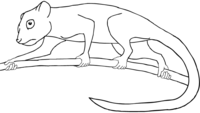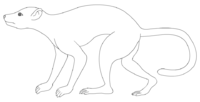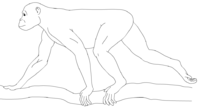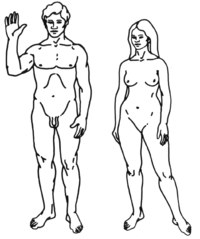مستخدم:Chaos/الخط الزمني للتطور الإنساني
الخط الزمني[عدل]
| Date | Event |
|---|---|
| 4000 MYA | The earliest life appears, possibly derived from self-reproducing RNA molecules. The copying/reproducing/replicating of these molecules requires resources like energy, space and smaller building blocks, which soon become limited, resulting in competition. Natural selection favors those molecules which are more efficient at replication. DNA molecules then took over as the main replicators. They soon develop inside an enclosing membrane which provide a stable physical and chemical environment conducive to their replication - the birth of proto-cells.
See: Origin of life For more about the Origins of cells, see: Origins of cells |
| 3900 MYA | Cells resembling prokaryotes appear. These first organisms are chemoautotrophs: they use carbon dioxide as a carbon source and oxidize inorganic materials to extract energy. Later, prokaryotes evolve glycolysis, a set of chemical reactions that free the energy of organic molecules such as glucose. Glycolysis generates ATP molecules as short-term energy currency, and ATP continue to be used in almost all organisms unchanged to this day. |
| 2500 MYA | First organisms to utilize oxygen. |
| 2100 MYA | More complex cells appear: the eukaryotes, which contain various organelles. The eukaryotic cell seems to have evolved from a symbiotic community of prokaryotic cells. The origin of the eukaryotic cell is a milestone in the evolution of life: their higher level of organizational complexity permits the development of truly multicellular organisms. |
| 1200 MYA | Sexual reproduction evolves, leading to faster evolution.[1] |
| 900 MYA |  The choanoflagellates are considered ancestors of the entire animal kingdom, and in particular may be the direct ancestors of sponges. The choanocytes (collar cells) of sponges have the same basic structure as choanoflagellates. Collar cells are occasionally found in a few other animal groups, such as flatworms. Comparisons of DNA sequences support a close affiliation between choanoflagellates and animals. |
| 850 MYA | Proterospongia (members of the Choanoflagellata) are the best living examples of what the ancestor of all animals may have looked like.
They live in colonies, and show a primitive level of cellular specialization for different tasks. The similarities between Proterospongia and sponges are strong evidence for the close relationship between protozoans and metazoans. |
| 600 MYA | It is thought that the earliest multicellular life on Earth was a sponge-like creature.
Sponges are among the simplest of animals, with partially differentiated tissues but without muscles, nerves, or internal organs. Sponges (Porifera) are the phylogenetically oldest animal phylum extant today. In some ways they are closer to being cell colonies than multicellular organisms. |
| 580 MYA | The movement of all animals may have started with cnidarians. Almost all cnidarians possess nerves and muscles and, because they are the simplest animals to possess it, their direct ancestors were very likely the first animals to use nerves and muscles together. Cnidarians are also the first animals with an actual body of definite form and shape. They have radial symmetry. |
| 550 MYA |  |
| 540 MYA | Acorn worms are considered more highly specialised and advanced than other similarly shaped worm-like creatures. They have a circulatory system with a heart that also functions as a kidney. Acorn worms have the gill-like structure it uses for breathing, a structure similar to that of primitive fish. Acorn worms are thus sometimes said to be a link between vertebrates and invertebrates. |
| 530 MYA | The earliest known ancestor of the chordates is Pikaia. It is the first known animal with a notochord. Pikaia is believed to be the ancestor of all chordates and vertebrates. The Lancelet, still living today, retains some characteristics of the primitive chordates. It resembles Pikaia Other earliest known chordate-like fossils is from a conodonts a "eel-shaped animal of 4-20 cm long" with a pair of huge eyes at the head end were and a complex basket of teeth. |
| 505 MYA |  The first vertebrates appear: the ostracoderms, jawless fish related to present-day lampreys and hagfishes. Haikouichthys and Myllokunmingia are examples of these jawless fish, or Agnatha. (See also prehistoric fish). They were jawless and their internal skeletons were cartilaginous. They lacked the paired (pectoral and pelvic) fins of more advanced fish. They were the Precursors to the bony fish. |
| 480 MYA | The Placodermi were prehistoric fishes. Placoderms were the first of the jawed fishes, their jaws evolving from the first of their gill arches [2]. Their head and thorax were covered by articulated armoured plates and the rest of the body was scaled or naked. |
| 400 MYA | First Coelacanth appears; this order of animals had been thought to have no extant members until living specimens were discovered in 1938. It is often referred to as a living fossil. |
| 375 MYA | Tiktaalik is a genus of sarcopterygian (lobe-finned) fishes from the late Devonian with many tetrapod-like features. |
| 365 MYA |  Some fresh water lobe-finned fish (Sarcopterygii) develop legs and give rise to the Tetrapoda. The first tetrapods evolved in shallow and swampy freshwater habitats. Primitive tetrapods developed from a lobe-finned fish (an "osteolepid Sarcopterygian"), with a two-lobed brain in a flattened skull, a wide mouth and a short snout, whose upward-facing eyes show that it was a bottom-dweller, and which had already developed adaptations of fins with fleshy bases and bones. The "living fossil" coelacanth is a related lobe-finned fish without these shallow-water adaptations. These fishes used their fins as paddles in shallow-water habitats choked with plants and detritus. The universal tetrapod characteristics of front limbs that bend backward at the elbow and hind limbs that bend forward at the knee can plausibly be traced to early tetrapods living in shallow water. Panderichthys is a 90-130 cm long fish from the Late Devonian period. It has a large tetrapod-like head. Panderichthys exhibits features transitional between lobe-finned fishes and early tetrapods. Lungfishes retain some characteristics of the early Tetrapodas. One example is the Australian Lungfish. |
| 315 MYA |
 Acanthostega is an extinct amphibian, among the first animals to have recognizable limbs. It is a candidate for being one of the first vertebrates to be capable of coming onto land. It lacked wrists, and was generally poorly adapted for life on land. The limbs could not support the animal's weight. Acanthostega had both lungs and gills, also indicating it was a link between lobe-finned fish and terrestrial vertebrates. Ichthyostega is an early tetrapod. Being one of the first animals with legs, arms, and finger bones, Ichthyostega is seen as a hybrid between a fish and an amphibian. Ichthyostega' had legs but its limbs probably weren't used for walking, they may have spent very brief periods out of water and would have used their legs to paw their way through the mud. Amphibia were the first four-legged animals to develop lungs. Amphibians living today still retain many characteristics of the early tetrapods. |
| 300 MYA |  From amphibians came the first reptiles: Hylonomus is the earliest known reptile. It was 20 cm long (including the tail) and probably would have looked rather similar to modern lizards. It had small sharp teeth and probably ate millipedes and early insects. It is a precursor of later amniotes and mammal-like reptiles. Evolution of the amniotic egg gives rise to the Amniota, reptiles who can reproduce on land and lay eggs on dry land. They did not need to return to water for reproduction. This adaptation gave them the capability to colonize the uplands for the first time. Reptiles have advanced nervous system, compared to amphibians. They have twelve pairs of cranial nerves. |
| 256 MYA |  Shortly after the appearance of the first reptiles, two branches split off. One is Synapsida: they had a pair of holes in their skulls behind the eyes, which were used to increase the space for jaw muscles. The other branch is Diapsida. From synapsids came the Therapsida, the direct ancestor of mammals. They are often called mammal-like reptiles. The earliest mammal-like reptilian are the pelycosaurs. The pelycosaurs was the first animals to have temporal fenestra. Pelycosaurs are not Therapsida but soon they gave rise to them. The therapsids have temporal fenestrae larger and more mammal-like than pelycosaurs, their teeth show more serial differentiation; and later forms had evolved a secondary palate. A secondary palate enables the animal to eat and breathe at the same time and is a sign of a more active, perhaps warm-blooded, way of life. |
| 220 MYA | One sub-group of therapsids, the cynodonts have evolved more mammal-like characteristics.
The jaws of cynodonts resemble modern mammal jaws more closely and their teeth are multi-cusped and differentiated down the jaw. Cynodonts are the direct ancestors of all modern mammals. |
| 220 MYA |  From eucynodonts (cynodonts) came the first mammals. Most early mammals were small and shrew-like animals that fed on insects. Constant body temperature. All mammals have milk glands for their young. Neocortex has evolved in mammals. This brain region is unique to mammals. The earliest mammals include:
|
| 125 MYA |  Eomaia scansoria, a eutherian mammal, leads to the formation of modern placental mammals. It looks like modern dormouse, climbing small shrubs in Liaoning, China. |
| 100 MYA | Common genetic ancestor of mice and humans. |
| 65 MYA |   A group of small, nocturnal and arboreal, insect-eating mammals called the Euarchonta begins a speciation that will lead to the primate, treeshrew and flying lemur orders. The Primatomorpha is a subdivision of Euarchonta that includes the primates and the proto-primate Plesiadapiformes. One of the early proto-primates is Plesiadapis. Plesiadapis still had claws and the eyes located on each side of the head, because of that they were faster on the ground than on the top of the trees, but they begin to spend long times on lower branches of trees, feeding on fruits and leafs. One of the last Plesiadapiformes is Carpolestes simpsoni. It had grasping digits but no forward facing eyes. |
| 40 MYA | Primates diverge into suborders Strepsirrhini (wet-nosed primates) and نسناسيات بسيطة الأنف (dry nosed primates). Strepsirrhini contains most of the prosimians; modern examples include the lemurs and lorises. The prosimian tarsiers, along with the simian monkeys and apes are the haplorrhines. One of the earliest haplorrhines is Teilhardina asiatica, a mouse-sized, diurnal creature with small eyes. |
| 30 MYA |  نسناسيات بسيطة الأنف splits into infraorders Platyrrhini and Catarrhini. Platyrrhines, New World monkeys, have prehensile tails and males are color blind. They may have migrated to South America on a raft of vegetation across the Atlantic ocean (circa 4,500km). Catarrhines mostly stayed in Africa as the two continents drifted apart. One ancestor of catarrhines might be Aegyptopithecus. Other ancient catarrhines include Bugtipithecus inexpectans, Phileosimias kamali and Phileosimias brahuiorum, which are all similar to today's lemurs. Soon catarrhine males gain color vision but lose the pheromone pathway. |
| 25 MYA |  Catarrhini splits into 2 superfamilies, Old World monkeys (Cercopithecoidea) and apes (Hominoidea). Proconsul was an early genus of catarrhine primates. They had a mixture of Old World monkey and ape characteristics. Proconsul's monkey-like features include thin tooth enamel, a light build with a narrow chest and short forelimbs, and an arboreal quadrupedal lifestyle. Its ape-like features are its lack of a tail, ape-like elbows, and a slightly larger brain relative to body size. Proconsul africanus is a possible ancestor of both great and lesser apes, and humans. |
| 15 MYA | إنسان ancestors speciate from the ancestors of the gibbon (lesser apes). |
| 13 MYA | إنسان ancestors speciate from the ancestors of the great apes.
Pierolapithecus catalaunicus is believed to be a common ancestor of humans and the great apes or at least a species that brings us closer to a common ancestor than any previous fossil discovery. Pierolapithecus had special adaptations for tree climbing, just as humans and other great apes do: a wide, flat ribcage, a stiff lower spine, flexible wrists, and shoulder blades that lie along its back. |
| 10 MYA | إنسان ancestors speciate from the ancestors of the gorillas. |
| 5 MYA |  إنسان ancestors speciate from the ancestors of the chimpanzees. The latest common ancestor is Sahelanthropus tchadensis.The earliest in the human branch is Orrorin tugenensis (Millennium Man, Kenya). Both chimpanzees and humans have a larynx that repositions during the first two years of life to a spot between the pharynx and the lungs, indicating that the common ancestors have this feature, a precursor of speech. |
| 4.4 MYA | Ardipithecus ramidus ramidus |
| 3.7 MYA | Some Australopithecus afarensis left footprints on volcanic ash in Laetoli, Kenya (Northern Tanzania). |
| 3 MYA | The bipedal australopithecines (early hominines) evolve in the savannas of Africa being hunted by Dinofelis. |
| 2 MYA |  الإنسان الماهر is thought to be the ancestor of the lankier and more sophisticated, إنسان عامل, which in turn gave rise to the more human appearing species, إنسان منتصب. There is debate over whether H. habilis is a direct human ancestor, and over how many known fossils are properly attributed to the species. see: Homo rudolfensis |
| 1.8 MYA |
إنسان منتصب evolves in Africa. Homo erectus would bear a striking resemblance to modern humans, but had a brain about 74 percent of the size of modern man. Its forehead is less sloping and the teeth are smaller. It is believed to be an ancestor of modern humans (with إنسان هايدلبيرغ usually treated as an intermediary step). |
| 1.75 MYA | Dmanisi man / Homo georgicus (Georgia, Russia), tiny brain came from Africa, with Homo erectus and Homo habilis characteristics. |
| 700 kYA | Common genetic ancestor of humans and Neanderthal. |
| 355 kYA | Three 1.5m tall إنسان هايدلبيرغ left footprints in powdery volcanic ash solidified in Italy. Homo heidelbergensis is the common ancestor of both نياندرتال and إنسان. It is morphologically very similar to إنسان منتصب but Homo heidelbergensis had a larger brain-case, about 93% the size of that of Homo sapiens. The species was tall, 1.8 m (6 ft.) on average, and more muscular than modern humans. |
| 195 kYA | Omo1, Omo2 (Ethiopia, Omo river) are the earliest إنسان |
| 160 kYA | Homo sapiens (الإنسان العاقل الأول) in Ethiopia, Awash River, Herto village, practise mortuary rituals and butcher hippos. |
| 150 kYA | Birth of the mitochondrial Eve in Africa. She is the most recent female ancestor common to all mitochondrial lineages in humans alive today. |
| 130 kYA | FOXP2 (gene associated with the development of speech) appears. |
| 100 kYA |  The first anatomically modern humans (إنسان) appear in Africa some time before this, they evolved from إنسان هايدلبيرغ. At present estimate, humans have approximately 20,000–25,000 genes and share 99% of their DNA with the now extinct Neanderthal [3] and 95% of their DNA with their closest living evolutionary relative, the chimpanzees[4]. إنسان skin is relatively hairless in comparison to other primates. The skin colour of contemporary humans can range from very dark brown to very pale pink. It is geographically stratified and in general correlates with the environmental level of UV. Human skin and hair colour is controlled in part by the MC1R gene. For example, the red hair and pale skin of some Europeans is the result of mutations in MC1R. Human skin has a capacity to darken (sun tanning) in response to UV exposure. Variation in the ability to sun tan is also controlled in part by MC1R. |
| 90 kYA | Modern humans enter Asia via two routes: one north through the Middle East, and another route further south from Ethiopia, via the Red Sea and southern Arabia. Mutation causes skin color changes in order to absorb optimal UV light for different geographical latitudes. Modern "race" formation begins. African populations remain more 'diverse' in their genetic makeup than all other humans, due to only a subset of their population (and therefore only a subset of their diversity) leaving Africa. See: Single-origin hypothesis |
| 74 kYA | Supervolcanoic eruption in Toba, Sumatra, Indonesia is believed to cause Homo sapiens population to crash to an estimated 2,000. 6 year nuclear winter, then a 1000 year ice-age. |
| 60 kYA | Birth of Y-chromosomal Adam in Africa (most likely Ethiopia or Sudan). He is the most recent common ancestor from whom all male human Y chromosomes are descended.
Y-chromosomal Adam is not the same individual at all points in human history. The most recent common patrilineal ancestor of humans alive today is different from the one for humans who will be alive a thousand years in the future: as male lines die out, a more recent individual, the Y-mrca of a subtree of the preceding Y-Adam, becomes the new Y-Adam. |
| 50 kYA | Modern humans expand from Asia to Australia (to become today's aborigines) and Europe. Expansion along the coasts happens faster than expansion inland. |
| 31 kYA | Modern humans enter North America from Siberia in numerous waves, some later waves across the Bering land bridge, but early waves probably by island-hopping across the Aleutians. At least two of the first waves had left few or no genetic descendants among Americans by the time Europeans arrived across the Atlantic Ocean. Humans reach Solomon Islands. Humans move into Japan.
M343, a genetic marker, first appears. This marker is estimated to have originated in an individual male in Africa 30,000 or more years ago and has propagated since then. This genetic marker is carried by most Western Europeans. It is carried by 70% of the entire population of England and 90% of some parts of Spain and Ireland and is also descended from the Cro-Magnon. |
| 27 kYA | Neanderthals die out, leaving Homo sapiens as the only living species of the genus Homo. |
| 10 kYA | Humans reach Tierra del Fuego at the tip of South America, the last continental region to be inhabited by humans (excluding Antarctica). |
Graphical timeline[عدل]

See also[عدل]
- مخطط زمني للكون
- تاريخ الأرض
- تاريخ طبيعي
- تاريخ العالم
- تطور الإنسان
- قائمة المتسحاثات البشرية
- Prehistoric amphibian
- سمك ما قبل التاريخ Prehistoric fish
- ثدييات ما قبل التاريخ Prehistoric mammal
- Prehistoric reptile
- الخط الزمني للتطور - an explanation of the evolution of a wide variety of animals living today
مراجع[عدل]
- ^ "'Experiments with sex have been very hard to conduct,' Goddard said. 'In an experiment, one needs to hold all else constant, apart from the aspect of interest. This means that no higher organisms can be used, since they have to have sex to reproduce and therefore provide no asexual control.'
Goddard and colleagues instead turned to a single-celled organism, yeast, to test the idea that sex allows populations to adapt to new conditions more rapidly than asexual populations." Sex Speeds Up Evolution, Study Finds (URL accessed on January 9, 2005) - ^ "Bones of first gill arch became upper and lower jaws." (Image) (URL accessed on November 16, 2006)
- ^ "Rubin also said analysis so far suggests human and Neanderthal DNA are some 99.5 percent to nearly 99.9 percent identical." Neanderthal bone gives DNA clues (URL accessed on November 16, 2006)
- ^ "The conclusion is the old saw that we share 98.5% of our DNA sequence with chimpanzee is probably in error. For this sample, a better estimate would be that 95% of the base pairs are exactly shared between chimpanzee and human DNA." Divergence between samples of chimpanzee and human DNA sequences is 5%, counting indels (URL accessed on November 16, 2006)
- The Ancestor's Tale (2004) ISBN 0-618-00583-8; Audio (2005) ISBN 0-7528-7321-0
وصلات خارجية[عدل]
[[تصنيف:خطوط زمنية بيولوجية]] [[تصنيف:علم الأحياء التطوري]] [[تصنيف:نظرية التطور]] [[تصنيف:تطور الإنسان|*]] [[ca:Línia temporal de l'evolució humana]] [[en:Timeline of human evolution]] [[pt:Linha do tempo da evolução]]



